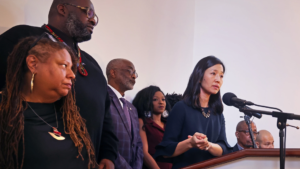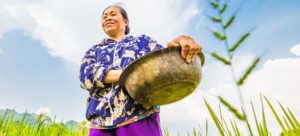GLASGOW, Scotland — Throughout the last week and a half, Indigenous peoples from around the world have been leading protests at the COP26 climate summit. On Tuesday, their aim was specific: They staged a memorial to draw attention to the connection between the oil and mining industries and the ongoing violence toward Indigenous women and queer, transgender and two-spirit people.
“Indigenous women have been viewed as disposable, consumable, much in the way Mother Earth has been treated as a consumable resource,” said activist Cheghajimixw, also known as Ta’Kaiya Blaney, from Canada’s Tla’amin Nation. “We’re here to make sure that the voices of the women we’ve lost are heard, and that those responsible for their disappearance know we are here.”
Indigenous women around the world face a significantly higher murder rate compared to other groups. In the United States, Indigenous women face murder rates that are 10 times higher than the national average. And in Canada, Indigenous women accounted for 16 percent of female homicides between 1980 and 2012, but only 4 percent of the population.
Advocates within Indigenous communities say this violence is exacerbated by extractive industries such as fossil fuels, logging and mining. According to Casey Camp-Horinek, Ponca Nation’s environmental ambassador, “man camps” move through Indigenous communities with little accountability, which can pose dangers to women in those communities — tribes don’t have jurisdiction over missing and murdered cases. “They just look at us as disposable,” she said.
Indeed, the influx of a male-dominated transient workforce in Indigenous territories correlate with increased rates of sexual violence, sexually transmitted diseases and human trafficking. The link between resource extraction and violence against Indigenous women, girls and two-spirit people is an extensivelydocumented phenomenon, such that in Canada, the National Inquiry into Missing and Murdered Indigenous Women and Girls made a recommendation that before a resource development project is approved, it must be assessed for the risks it poses to Indigenous women and LGBTQ individuals.
At the memorial on Tuesday, Indigenous groups from Canada, the United States and Ecuador sang traditional songs and shared the stories of women who went missing when such camps moved into their territories.
“The oil and gas industry, the polluters, those who are mining and destroying our Mother Earth, we hold them accountable for the harms that they are doing our homeland, to our earth and to the women of our communities,” said Bineshi Albert, from the Yucci and Anishinaabe communities and who is protesting in Glasgow. “We’re here to say: not one more.”
The Indigenous groups gathered within the blue zone at COP26, an area reserved for those participating in the conference, before marching out onto the nearby streets where they were met with crowds in the hundreds. Indigenous groups wore red to remember those whose lives were taken.
The memorial was held on COP26’s gender day, which recognizes the impact of the climate crisis on women and calls for integrating gender equality into climate policy and action. This has been a fraught topic at the talks; groups representing Indigenous communities, women and LGBTQ individuals have said they have been shut out of key negotiations. As Casey Camp-Horinek pointed out, the largest delegation at COP26 belongs to the fossil fuel industry.

But marginalized groups have the most at stake when it comes to the climate crisis: Experts say that women and girls stand to be disproportionately impactedby climate change. In addition to sexual violence, women are more exposed to economic instability, displacement and death, and girls could be subject to removal from school or early marriage.
Women activists fighting for Indigenous, environmental and gender rights also face significant threats for their work. Such violence has increasingly gained international attention; in 2016, Berta Cáceres, a prominent environmental rights activist in Honduras, was assassinated, leading to global outcry about the murdering of Indigenous women activists.
“Indigenous women are the primary line of defense against the violence perpetuated by extractive industries on our territories,” said Mireya Gualinga, member of the government advisory board of the Kichwa Community of Sarayaku, Ecuador. “We defend with our own bodies the health of our families, communities and lands, and we fight every day against the colonialist exploitation of multinationals from the global North.”
Some activists are hopeful that governments are paying more attention to the issue, from a new Missing & Murdered Unit under the Bureau of Indian Affairs in the United States to a plan in Canada released earlier this year to address the violence. But many women at the memorial said they are tired of having to share their stories over and over again without seeing action from world leaders.
“This morning, I woke up knowing this event was coming and asked for strength to tell you about the ones just in our territory alone that are never cared for,” said Camp-Horinek, who teared up as she spoke. But Camp-Horinek is not giving up, she said: Young people give her hope.
“People are going to rise like the water,” she said. “They’re going to calm this crisis down.”




